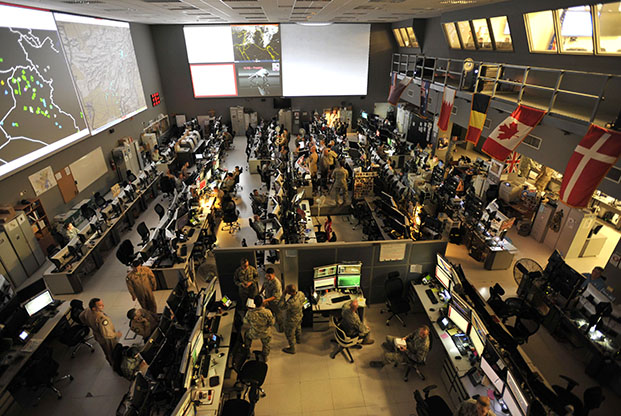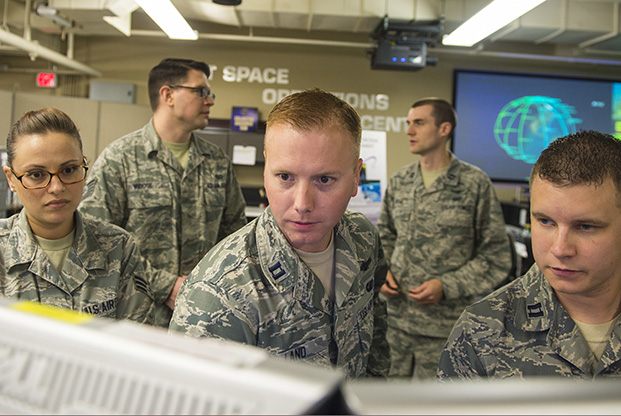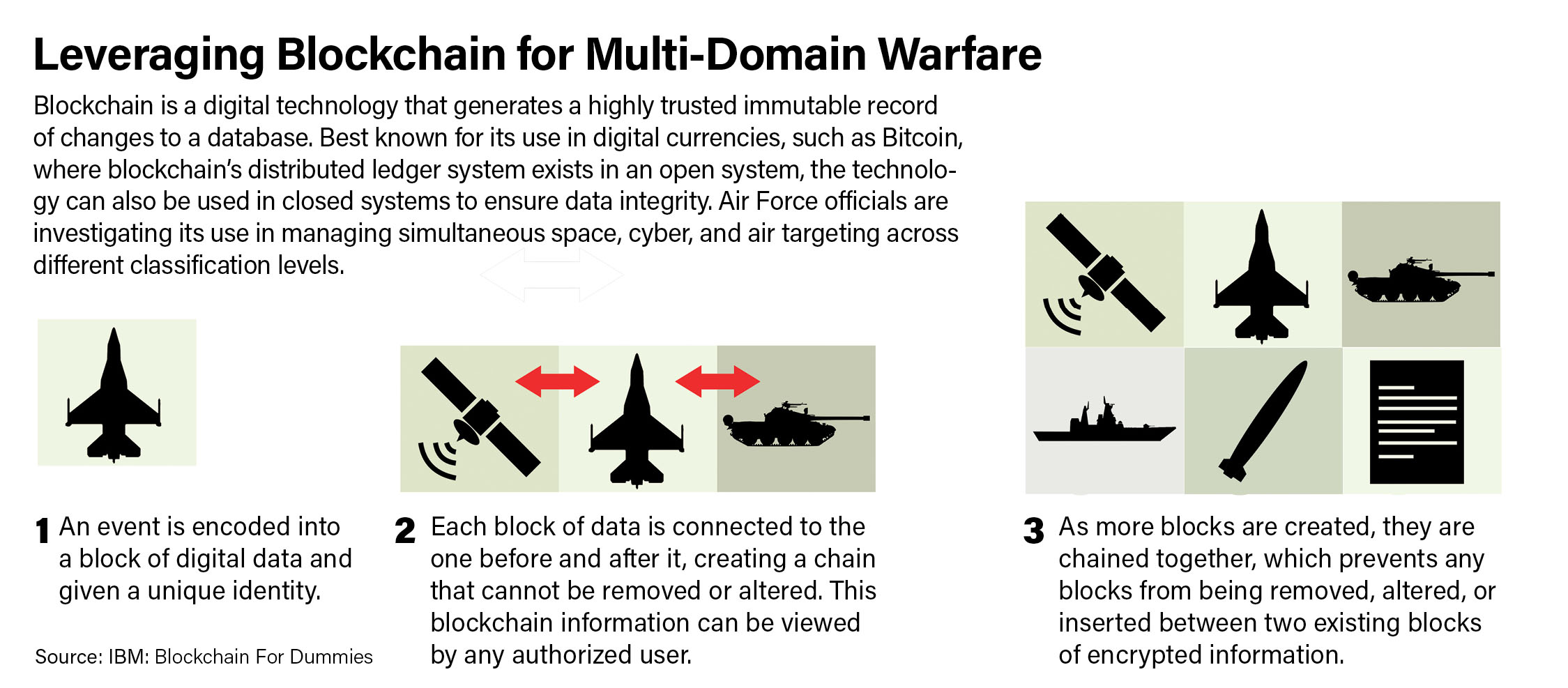
The Combined Air Operations Center at Al Udeid AB, Qatar, provides command and control to airpower throughout Iraq, Syria, and 17 other nations.MDC2 means injecting a fuller understanding of other domains in the CAOC. Photo: TSgt. Joshua Strang
Barely two years after Air Force Chief of Staff Gen. David L. Goldfein laid out his vision for multi-domain command and control, the concept is beginning to take root.
This month, a select group of 34 mid-career officers will head to Hurlburt Field, Fla., for the Air Force’s inaugural MDC2 training course, where they will prepare for a new career field known as 13O, or “13-Oscar.” Meanwhile, about 1,400 miles away, a team at Hanscom AFB, Mass., is in the early stages of developing new tools and technologies for the job.
And for the first time, the Air Force’s budget breaks out plans to dedicate $150.8 million to MDC2 research and development in 2020.
Goldfein’s once-abstract proposal—airmen should think outside their silos to wage smarter, faster war—is beginning to take shape.
MAKING A 13-OSCAR
The 13O course establishes clear steps for teaching airmen to understand multi-domain capabilities and is a primer on the joint planning process, according to Col. Francisco M. Gallei, the 505th Training Group commander at Hurlburt Field.
“We’ve always done multi-domain operations,” Gallei told Air Force Magazine in a March 12 interview. “The problem is, we just haven’t done it really, really well. A lot of multi-domain operations or capabilities have been brought to execution as an afterthought.”
To combat that tendency, the course will approach MDC2 in three parts:
- How the air component works and how it integrates with higher authorities. Airmen will study joint planning and targeting and learn the role of intelligence and mobility assets, Gallei said.
- How the other service components work and what capabilities warfighters in each domain—air, land, sea, space, cyber—can bring to bear. Students will learn how to collaborate with other armed forces, interagency partners, and coalition members. The curriculum is being developed in consultation with the other services and coalition partners, who will teach the lessons concerning their branches and components.
- How to plan joint exercises and operations.
In the second phase, Gallei said, “We’ll be doing what we call micro-joint planning exercises: They’ll be presented a problem, and they’ll have to go through the planning process in order to come up with a multi-domain solution.”
Instead of building an air-centric plan, officers will learn to consider effects in any domain. Could a cyber effect make more sense? Would a naval capability be useful? How might a space asset help? What are the risks and benefits of a kinetic effect versus an electronic attack
MDC2 operators do not have to memorize all the capabilities a domain can offer, but instead must know how to reach back to subject-matter experts who can provide the right options.
Those skills are essential for the third phase of the course, when students take on bigger joint planning exercises.
“They’ll be given, for example, a scenario and then the students will have to plan just as if they were on the air component staff or a joint staff, going through the whole joint planning process,” Gallei said.
Students will likely visit the Combined Air Operations Center at Nellis AFB, Nev., and be evaluated on their performance on an operations floor.
After completing the training, graduates will be assigned to AOCs around the world, initially regional AOCs in the US and overseas and, later, functional AOCs at USAF major commands.
“The plan, of course, is that as we get more students through the pipeline, that’ll expand naturally to the … joint headquarters and those kinds of things,” Gallei said.
A few classes will need to cycle through before instructors start getting feedback from the field—for instance, whether exercise scenarios should be tweaked or if students don’t grasp current technologies, he added. He noted the Air Force doesn’t need to adopt any particular new tools before it can teach MDC2.
The first 20-week course will start May 28 with 34 officers—about half of those who applied—according to Air Force spokesman Maj. Bryan Lewis. The course will run twice a year and aims to graduate about 70 13Os each year.
Mid-career officers with about a decade of experience in any specialty are eligible to apply.
Graduates of Air University’s 10-month multi-domain operational strategist program can also become 13Os, Gallei said. Maxwell AFB, Ala., officials did not comment for this story.
Some argue that waiting until so late in an officer’s career to teach multi-domain concepts is a mistake. Air Force Secretary Heather Wilson said in 2018 that the service should start MDC2 training earlier.
But Gallei and Air Force Operations Director Brig. Gen. B. Chance Saltzman, who ran the service’s yearlong study of MDC2 in 2017, argue 13-Oscars need substantial tactical experience in air operations, satellites, and cyber operations before they can be effective MDC2 planners. Once they achieve that designation, they’ll remain in that capacity, rather than do it for one tour and rotate back to their speciality. As a result, operational experience is critical to inform their general understanding.
“The new career field is opening up opportunities for officers to serve at the operational level for an extended period of time,” Lt. Col. Andrew Smith, 19th Airlift Wing staff director, said in a January news release. “These officers will gain valuable experience while increasing continuity and effectiveness of operations.
The key to their success lies in the Air Force’s ability to ensure becoming a 13-O is not a dead end. “If there are no opportunities for a 13-Oscar, “ Gallei said, “eventually you will get folks who are not interested.
Planners have to “stay current on capabilities,” he said. “Part of the course is to teach them the capabilities and where to ask for capabilities, who to go to. … I really don’t see a lot of things changing in the way people interact at the AOC.”
Existing C2 training courses are already feeling the ripple effects of the service’s MDC2 pivot. Air C2 operators see information about other domains in their initial qualification training, Gallei said, and space and cyber operators are learning more about AOCs.
“I think there will be some goodness, some bleed-over in capability and training between the 13-Oscars who are really focusing on the multi-domain piece and the joint planning piece to the [initial qualified training] students coming in brand-new,” he said.
While Gallei said the ultimate size of the career field depends on the service’s capacity, Saltzman has said he expects to reach around 500 13O billets.
According to slides Saltzman presented at a MITRE Corp. conference last summer, certain billets at AOCs would be converted to MDC2 jobs. He anticipated the Air Force will eventually have 250 majors, 125 lieutenant colonels, and 25 colonels working on MDC2.
Those who will succeed in the field are lifelong learners, students of history and current affairs who are eager to expand their horizons, Gallei said.

Airmen at the Joint Space Operations Center monitor computer systems to detect, track, and identify artificial objects in Earth orbit at Vandenberg AFB, Calif. New 13-Oscar officers must learn what effects can be achieved in air, space, cyber, sea, and ground operations. Photo: A1C Krystal Ardrey
BUILDING THE TOOL KIT
To succeed, the Air Force also needs the digital tools to make decisions quickly. In February, a new Multi-Domain Command and Control Capabilities Office laid out its vision and priorities to more than 100 companies and partners at its first Industry Day in Lexington, Mass. The goal is to develop a new process and information architecture that will enable warfighters to be more effective in the heat of battle.
“Enhancing old processes and capabilities is insufficient to meet the ‘high-end’ fight,” said Sheryl Thorp, the office’s program manager, and Russ Jimeno, its chief engineer, in written responses sent March 8. “This office has been tasked with standing up an enduring experimentation campaign to consistently experiment and identify innovative ways to meet 2030-and-beyond future warfare.”
They’re working with Eileen Vidrine, the Air Force’s new chief data officer, to sketch out an architecture that can share data across systems in different domains.
One of the office’s first initiatives will explore using blockchain—the same tamper-proof database technology behind Bitcoin and other digital currencies—to “experiment with performing simultaneous space, cyber, and air targeting across classification levels,” according to Industry Day slides.
The Air Force also wants to demonstrate it can autonomously collect, process, and share command and control data from an airborne platform.
“Shadow Net,” a data-processing network set up between several military sites in the US, aims to eventually include that airborne node.
The Shadow Net “will create a specific data location where multiple sensors can input information,” the service said in a Feb. 25 release. “Airmen and combatant commanders can read and process that information in order to make fully informed battlefield decisions.”
Thorp and Jimeno said they would issue requests for proposals for the blockchain and mobile C2 node initiatives “in the near-term.” AFWERX has its own data-fusion effort underway to support the MDC2 Capabilities Office.

Following an agile software development model, each experiment will last a year or less, broken down into six-month sprints, to reduce the risk of locking in old technology, considering it changes so quickly, the officials said. Other efforts will focus on identity management, artificial intelligence, machine learning, automation, and data sharing among various classification levels.
Identity management is critical to this challenge, Saltzman told Inside Defense in December 2018.
“We have to do a better job of expressing in policy terms the risk framework for sharing information,” he said. “Even among ourselves, need-to-know is really indiscriminate. If you’re a US person in the military but don’t have a need to know, I cut you off the same as if you’re a coalition partner that I’ve determined doesn’t have a need to know.”
The Air Force must approach C2 assets more holistically, rather than thinking about them as independent programs and hoping they align, Saltzman said.
The new office is reaching out to those who run current C2 systems to figure out how to work existing technology into the experimentation campaign.
“In our experimentation, if technology or services can support the operational communities, our goal is to … leverage that capability soonest,” Thorp and Jimeno said.
Industry was “very responsive” to what they heard at the February gathering, the officials added.
Traditional defense firms worry that the focus on innovation, emerging technology, and startups will blind the Air Force to the capabilities of its traditional supplier base. Lockheed Martin, for example, has tried to woo the Air Force with significant investment in MDC2 tools and a war game series now on its fifth iteration. Company officials told reporters at AFA’s Air Warfare Symposium in March that Lockheed will align resources across all of its business areas to push the MDC2 envelope even further.
Thorp and Jimeno acknowledged that traditional suppliers are part of the discussion. “We have been talking with many companies to include Lockheed, discussing their activities and tracking their innovative ideas,” they wrote. “There are many areas to collaborate.”
‘ONE BITE AT A TIME’
The multi-domain theme is spreading across the service in other ways. For example, Air Education and Training Command will soon tie multi-domain warfare into its Pilot Training Next initiative.
Vice Chief of Staff Gen. Stephen W. Wilson is also challenging airmen this year to “harness the human-machine teaming technology found in the myriad of apps on portable devices and deliver a similar situational awareness capability for the joint force.” Meanwhile, solicitations for new MDC2 research efforts regularly appear online.
What’s next? Gallei thinks sister-service participation in the 13O career field could spur the Army and Navy to send students to the Air Force’s course, or encourage them to develop their own multi-domain warfare courses. The MDC2 Capabilities Office is involving the other services early in its experiments to better address joint data-sharing issues.
“Whether you’re talking training and education, adapting advanced technologies, or creating new operational concepts, it’s a big animal,” Saltzman said last September. The Air Force can’t swallow it all in one move.
“We intend to eat it—one bite at a time.”
